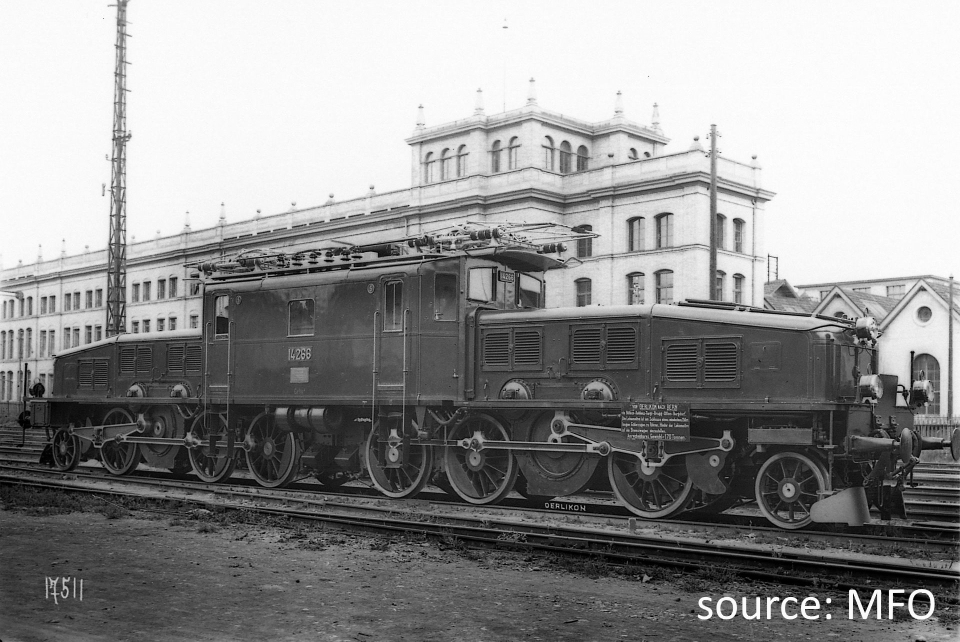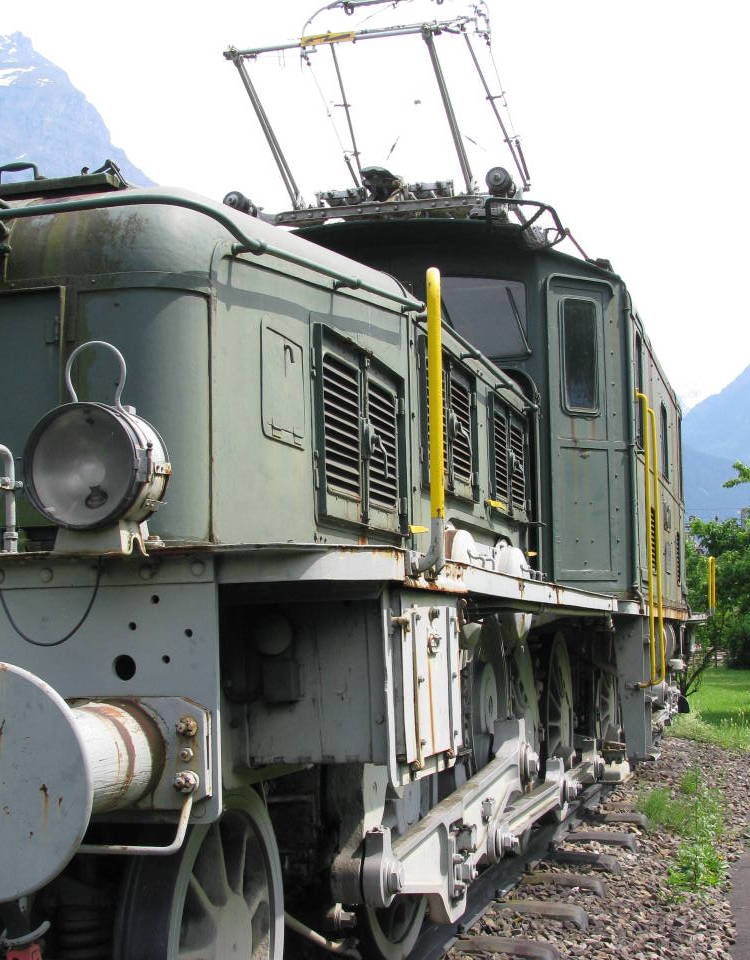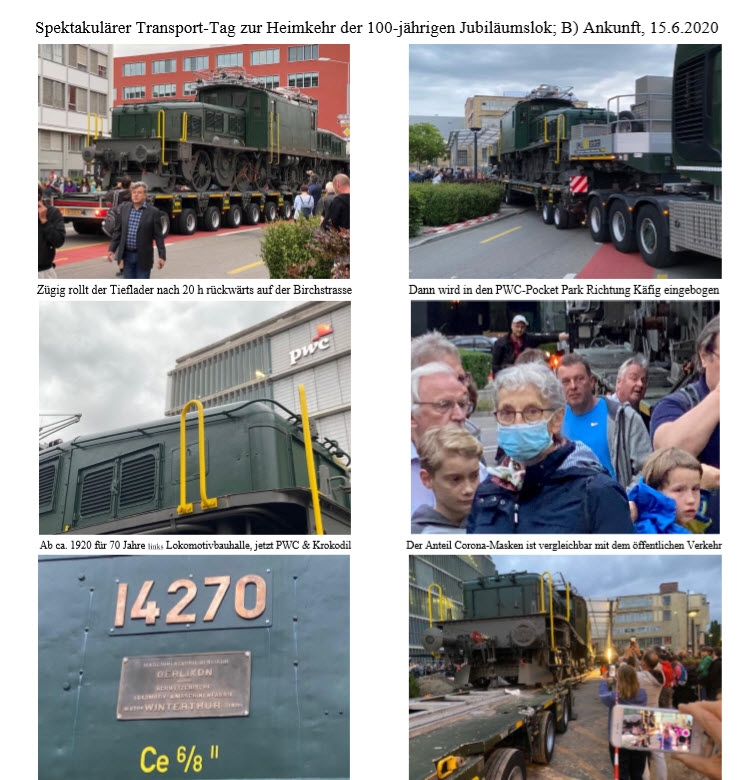Latest news
The latest news item was posted 1912 days ago:
22.09.2020 :
Temporary change of web domain
08.09.2020 :
Ceneri Base Tunnel opens
08.09.2020 :
Liechtenstein S-Bahn rejected
08.09.2020 :
Flexity not yet in service
08.09.2020 :
Zürich's first Flexity
older news items
all news for current year index, on one page
This website:
news search.
Zürich tram home page.
photos.
events diary.
Zürich tram links.
guestbook.
Crocodile locomotive finally returns to Oerlikon
filed on: 05.08.2020 (5th Aug 2020)
A dream finally came true.
 The SBB crocodiles are among the most iconic of all Swiss locomotives. 51 were built between 1919 and 1927 for the electrification of the Gotthard railway. With their long snouts, large wheels, steam-engine-like coupling rods and hinged construction, they were fascinting to observe in action, whether spiralling around the church at Wassen or shunting in a freight yard. Following the arrival of larger locomotives on the Gotthard route in the 1950s and 60s, the crocodiles were displaced onto lesser duties, with many surviving on freight duties into the 1970s. A number of modified locomotives were even used for shunting in the Basel docks until 1986.
The SBB crocodiles are among the most iconic of all Swiss locomotives. 51 were built between 1919 and 1927 for the electrification of the Gotthard railway. With their long snouts, large wheels, steam-engine-like coupling rods and hinged construction, they were fascinting to observe in action, whether spiralling around the church at Wassen or shunting in a freight yard. Following the arrival of larger locomotives on the Gotthard route in the 1950s and 60s, the crocodiles were displaced onto lesser duties, with many surviving on freight duties into the 1970s. A number of modified locomotives were even used for shunting in the Basel docks until 1986.
With their immense popularity among both enthusiasts and the public at large, it is no surprise that numerous examples were preserved, some of which are operational. According to Wikipedia, of the 33 locomotives of the earlier variant, Ce 6/8ii, seven survive, and of the 18 of the later variant, Ce 6/8iii, three survive.
 One locomotive that survived but did not get the care or attention it deserved was Ce 6/8ii 14270, which was plinthed outside SBB's Ersttfeld depot until 2013 (seen on the photo here in 2010, more views here), and looking increasingly sorry for itself. The group OERLIKON Industriegeschichten hatched a plan for bringing this machine home to Oerlikon. A plan that has finally been achieved.
One locomotive that survived but did not get the care or attention it deserved was Ce 6/8ii 14270, which was plinthed outside SBB's Ersttfeld depot until 2013 (seen on the photo here in 2010, more views here), and looking increasingly sorry for itself. The group OERLIKON Industriegeschichten hatched a plan for bringing this machine home to Oerlikon. A plan that has finally been achieved.
The mechanical part of the crocodiles was built by SLM in Winterthur. The electrical equipment was subsequently fitted by MFO in Oerlikon (MFO, Maschinenfabrik Oerlikon was bought out by BBC in 1967, which in turn became part of ABB in 1988. The present "Cityport" headquarters of ABB is on the site of a former MFO factory adjoining Oerlikon station). The crocodiles were assembed in a different MFO factory located approximately where the PWC building now stands on Binzmühlestrasse. The tracks were still visible here until recently, but have vanished in connection with the ongoing redevelopment work that transformed the entire area. At one time a long and partly street-running industrial track connected to SBB at both ends, at both Oerlikon and Seebach stations, and branched to serve various industries in the area. The locomotive now stands more or less on a small part of the former alignment of the "main line" of this track.
 After it ceased to be used for industrial purposes, the great assembly hall served as a musical theatre for several years but could unfortunately not be saved. Today very little remains that bears witness to Oerlikon's once great industrial prowess. Bringing 14270 home and displaying it on a plinth outside the PWC building will help redress that loss and serve to mark the birthplace of this remarkable locomotive type.
After it ceased to be used for industrial purposes, the great assembly hall served as a musical theatre for several years but could unfortunately not be saved. Today very little remains that bears witness to Oerlikon's once great industrial prowess. Bringing 14270 home and displaying it on a plinth outside the PWC building will help redress that loss and serve to mark the birthplace of this remarkable locomotive type.
It took many years of fundraising as well as political campaigning to make the project possible. But finally on 15th June it happened. The locomotive had previously been cosmetically overhauled in the SBB workshops in Biel and towed to Oerlikon by an SBB Re 4/4. From here it made the last leg of its journey to its plinth by low-loader lorry. The plinth has a roof to protect the locomotive from the rain. A touch screen display will inform visitors about its history. OERLIKON Industriegeschichten is still seeking donations to finalize and maintain the exhibit.
The screenshot above is from industriegeschichten.ch and can be enlarged here.
This news item is from the 2020 newslog.
search Zürich tram news archive
news index for 2025
all news for current year
Zürich tram homepage
to link to this item please use:
http://www.proaktiva.ch/tram/zurich/newslog/newsitem.php?year=2020&item=050820